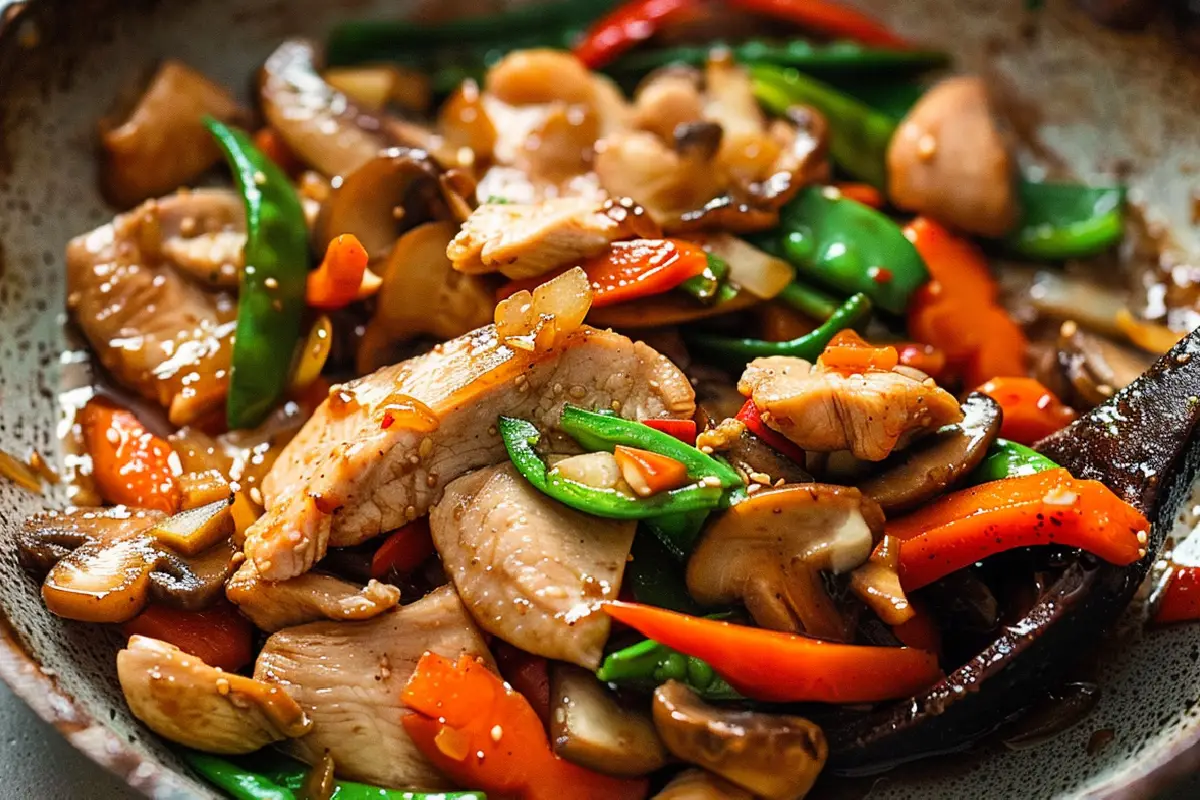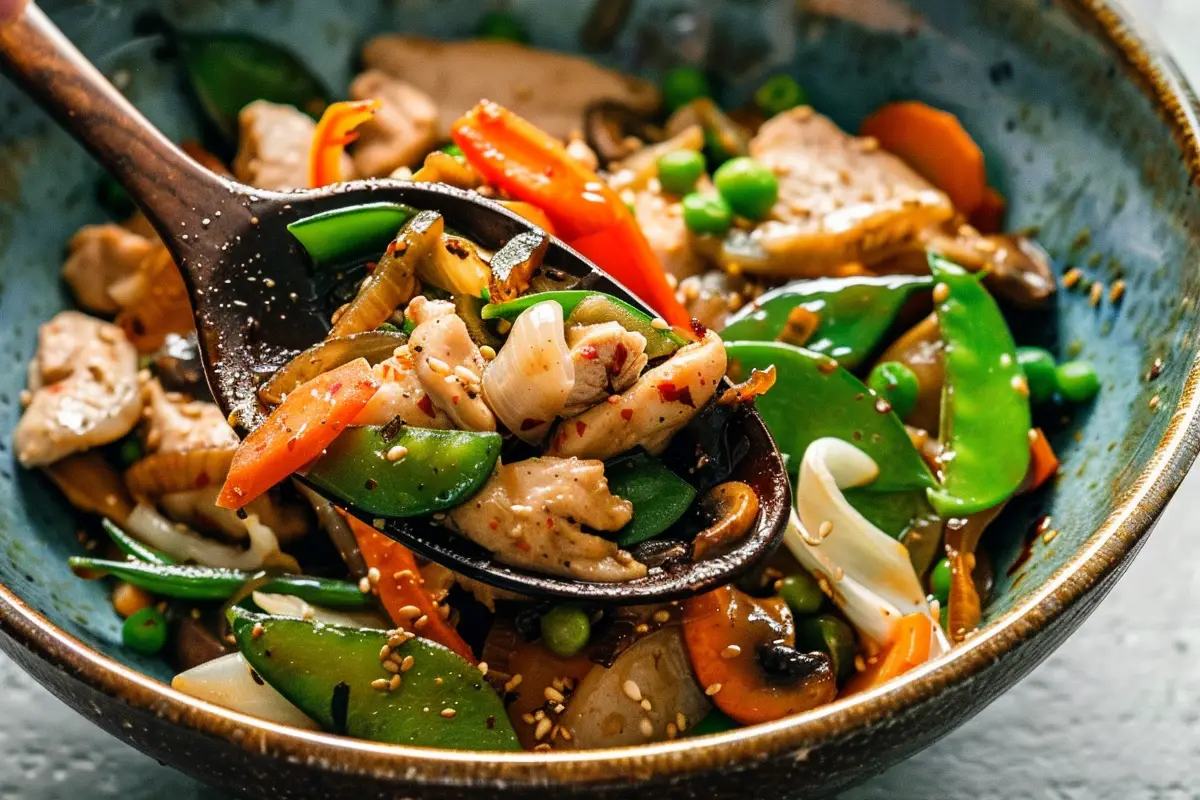Moo Goo Gai Pan is a classic Chinese stir-fry dish that combines tender chicken, savory mushrooms, and fresh vegetables in a light, flavorful sauce. This Cantonese-inspired dish is loved for its balanced flavors, simplicity, and adaptability, making it perfect for both beginners and seasoned cooks. Whether you enjoy it at a Chinese restaurant or whip it up at home, Moo Goo Gai Pan is a popular choice for a light yet satisfying meal.
What is Moo Goo Gai Pan?
Moo Goo Gai Pan translates to “sliced chicken with mushrooms,” which highlights the main ingredients of the dish. Traditionally, it includes chicken, mushrooms, and a variety of crisp vegetables like snow peas, bamboo shoots, and water chestnuts. These are stir-fried together in a savory sauce, creating a dish that is mild yet full of flavor. You’ll often find the dish on Chinese-American restaurant menus because of its accessibility and taste.
Why People Love Moo Goo Gai Pan
Moo Goo Gai Pan stands out among Chinese stir-fry dishes due to its balance of textures and clean, light flavors. Unlike spicier or heavier Chinese dishes, Moo Goo Gai Pan highlights the freshness of its ingredients without overpowering them with sauce. It’s perfect for those who want a lighter stir-fry that still delivers delicious taste.
- Health Benefits: Moo Goo Gai Pan is naturally low in fat, high in protein, and packed with vegetables, making it a great option for those looking for a healthy stir-fry.
- Versatility: You can easily customize this dish by swapping in your favorite vegetables or proteins while maintaining its core essence.
- Ease of Preparation: With simple techniques like stir-frying and velveting, Moo Goo Gai Pan is accessible for all home cooks, making it a quick and easy meal for busy weeknights.
The History of The Dish
Origins in Cantonese Cuisine
Moo Goo Gai Pan comes from Cantonese cuisine, which emphasizes fresh, lightly seasoned ingredients and quick cooking methods that preserve the natural flavors of the food. In traditional Cantonese cooking, dishes like Moo Goo Gai Pan showcase simple yet elegant use of fresh ingredients, focusing on balance and harmony.
Moo Goo Gai Pan in America
The dish became widely popular in the United States during the 1970s as Chinese-American cuisine grew in popularity. Cantonese immigrants brought their culinary traditions to America, where Moo Goo Gai Pan quickly became a favorite for its mild flavors and broad appeal. American chefs adapted the dish, adding a wider variety of vegetables and sometimes substituting chicken with other proteins to cater to local tastes.
The dish’s adaptability has helped it thrive in Chinese-American cuisine, becoming a staple on menus nationwide. To learn more about traditional Chinese cooking techniques, explore Chinese Cooking Techniques to discover what makes dishes like Moo Goo Gai Pan special. Additionally, mastering the velveting technique—a key to achieving the tender texture of the chicken—can elevate your home cooking. Check out How to Velvet Chicken for Stir-Fry to learn this essential skill.
Key Ingredients and Cooking Techniques

Key Ingredients of The Recipe
The beauty of Moo Goo Gai Pan lies in its simplicity and quality of ingredients. Let’s take a closer look at the main components:
- Chicken: Boneless, skinless chicken breast is the top choice because it’s lean and tender. Slicing it thinly against the grain ensures it cooks quickly and evenly.
- Mushrooms: Crimini and Shiitake mushrooms are the go-to options, adding a rich, earthy flavor that pairs well with the chicken. The mushrooms bring umami and a pleasing texture to the dish.
- Vegetables: Common vegetables include snow peas, bamboo shoots, water chestnuts, and sometimes bell peppers or baby corn. These add crunch, color, and nutrients to the dish.
- Sauce: A light mix of oyster sauce, soy sauce, chicken stock, and cornstarch ties the dish together, enhancing the natural flavors without overwhelming them.
Cooking Techniques: Stir-Frying and Velveting
Moo Goo Gai Pan’s unique texture and flavor come from two main cooking techniques: stir-frying and velveting.
Stir-Frying
Stir-frying cooks food quickly over high heat, preserving the freshness and crunch of the ingredients. It’s a signature method in Cantonese cooking that keeps vegetables crisp and chicken tender.
- Tips for Stir-Frying:
- Use a wok or large skillet to give ingredients enough space to cook evenly.
- Preheat the wok until very hot before adding oil; this helps create a smoky flavor known as “wok hei.”
- Keep the ingredients moving constantly to prevent burning and ensure even cooking.
Velveting
Velveting involves coating the chicken in a mix of egg white, cornstarch, and oil, then briefly frying or blanching it before stir-frying. This technique gives the chicken a silky, tender texture.
- Velveting Tips:
- Marinate the chicken for 20-30 minutes to allow the mixture to coat the meat fully.
- Use just enough oil to coat the chicken without deep frying; the goal is to enhance texture, not to brown the chicken.
- Drain the chicken thoroughly after velveting to keep the stir-fry light.
These techniques are essential for achieving the perfect Moo Goo Gai Pan and are great skills for any cook interested in mastering Chinese stir-fry dishes.
Modern Variations and Adaptations
Americanized Versions
As Moo Goo Gai Pan became more popular in the United States, chefs began to adapt it to suit different tastes. Common variations include:
- Alternative Proteins: While chicken is the classic choice, proteins like pork, shrimp, and tofu work well, each bringing a unique flavor and texture.
- Expanded Vegetables: Bell peppers, broccoli, carrots, and snap peas often appear in American versions, adding nutrition and visual appeal. These vegetables enhance both flavor and texture, offering a satisfying crunch in every bite.
- Sauce Adjustments: Some versions use a sweeter or spicier sauce, with additions like hoisin sauce, garlic chili paste, or ginger for extra depth and a hint of heat.
How to Customize Moo Goo Gai Pan at Home
The dish is incredibly adaptable. Here’s how you can make it your own:
- Add More Vegetables: Increase the variety of veggies to boost the dish’s fiber and nutrients. Options like asparagus, zucchini, or bok choy work great.
- Adjust the Sauce to Taste: For a lighter flavor, use low-sodium soy sauce and reduce the oyster sauce. To make the dish richer, add a splash of sesame oil or a pinch of sugar.
- Spice It Up: For those who love heat, add red pepper flakes or a spoonful of chili paste.
If you’re looking to explore more stir-fry variations, check out recipes like Bang Bang Chicken for a spicy, creamy twist or Hibachi Chicken for a smoky, restaurant-style experience.
Step-by-Step Recipe Guide
Ingredients and Preparation
Ingredients:
- 12 oz chicken breasts, thinly sliced against the grain
- 4 oz Crimini mushrooms, sliced
- 4 oz Shiitake mushrooms, sliced
- 2 oz bamboo shoots, thinly sliced
- 2 cloves garlic, thinly sliced
- 4 slices of fresh ginger
- 1/3 cup vegetable oil
- Sauce: 1/4 cup rice wine, 1/2 cup chicken stock, 2 tbsp oyster sauce, 1 tbsp soy sauce, 1 tbsp cornstarch.
Preparation Steps:
- Velvet the Chicken: Mix chicken slices with egg white, cornstarch, salt, and pepper. Let it marinate for 20-30 minutes.
- Prepare Vegetables: Slice mushrooms, bamboo shoots, garlic, and ginger. Keep them in separate bowls for easy access during cooking.
- Make the Sauce: In a small bowl, combine rice wine, chicken stock, oyster sauce, soy sauce, and cornstarch. Stir until the cornstarch dissolves.
Cooking Instructions
- Heat the Wok: Preheat a wok or large skillet over medium-high heat. Add vegetable oil and swirl to coat the sides.
- Cook the Chicken: Add the marinated chicken, stirring constantly to separate the pieces. Cook for about 2 minutes until the chicken is mostly done, then set it aside.
- Stir-Fry the Aromatics: In the same wok, add more oil if needed. Stir-fry garlic and ginger until fragrant, about 30 seconds.
- Add the Vegetables: Toss in the mushrooms, bamboo shoots, and any other vegetables. Stir-fry for 2-3 minutes until just tender but still crisp.
- Combine and Sauce: Return the chicken to the wok and pour in the sauce. Stir well to thicken the sauce evenly. Cook for another 1-2 minutes until the chicken is fully cooked and everything is well coated.
- Serve: Garnish with sliced scallions or fresh cilantro, and serve hot over steamed rice or noodles.
Nutritional Benefits and Health Considerations
Health Highlights of Moo Goo Gai Pan
The dish offers a nutritious meal that’s both delicious and healthy:
- High in Protein: The lean chicken provides high-quality protein, essential for muscle maintenance and overall health.
- Low in Fat and Calories: With minimal oil and a light sauce, Moo Goo Gai Pan is lower in fat and calories compared to other stir-fries, making it ideal for those watching their diet.
- Rich in Vitamins and Antioxidants: The mushrooms and vegetables are packed with vitamins, fiber, and antioxidants, which help support a healthy immune system. Discover more about the Health Benefits of Mushrooms, a key component of this dish.
Tips for Making a Healthier Moo Goo Gai Pan
- Reduce Sodium: Use low-sodium soy sauce and limit the oyster sauce for a heart-healthier version.
- Increase Vegetables: Adding more vegetables boosts the dish’s fiber and nutrients without adding many calories.
- Go Gluten-Free: Use tamari or a gluten-free soy sauce alternative to make this dish suitable for those with gluten sensitivities.
FAQs
- What is Moo Goo Gai Pan?
- A classic Cantonese stir-fry with chicken, mushrooms, and vegetables in a light sauce.
- How is Moo Goo Gai Pan different from other stir-fry dishes?
- The velveting technique creates a unique, tender texture for the chicken, setting it apart from other stir-fries.
- Can I use other proteins?
- Yes, pork, shrimp, or tofu can be substituted for chicken, offering different textures and flavors.
- Is Moo Goo Gai Pan gluten-free?
- It can be made gluten-free by using gluten-free soy sauce and ensuring other sauce ingredients are free of gluten.
- What vegetables can be added?
- Snow peas, bell peppers, carrots, and broccoli are great additions that enhance the dish’s flavor, texture, and nutritional value.
Conclusion

The dish is more than just a stir-fry; it’s a celebration of fresh ingredients and traditional cooking techniques. Whether you stick to the classic recipe or add your own twist, Moo Goo Gai Pan provides a delicious, healthy meal that’s easy to make and always satisfying. Enjoy the light, balanced flavors of this timeless dish, and explore similar recipes like Bang Bang Chicken and Hibachi Chicken for more Chinese-inspired meals that bring excitement to your kitchen.

